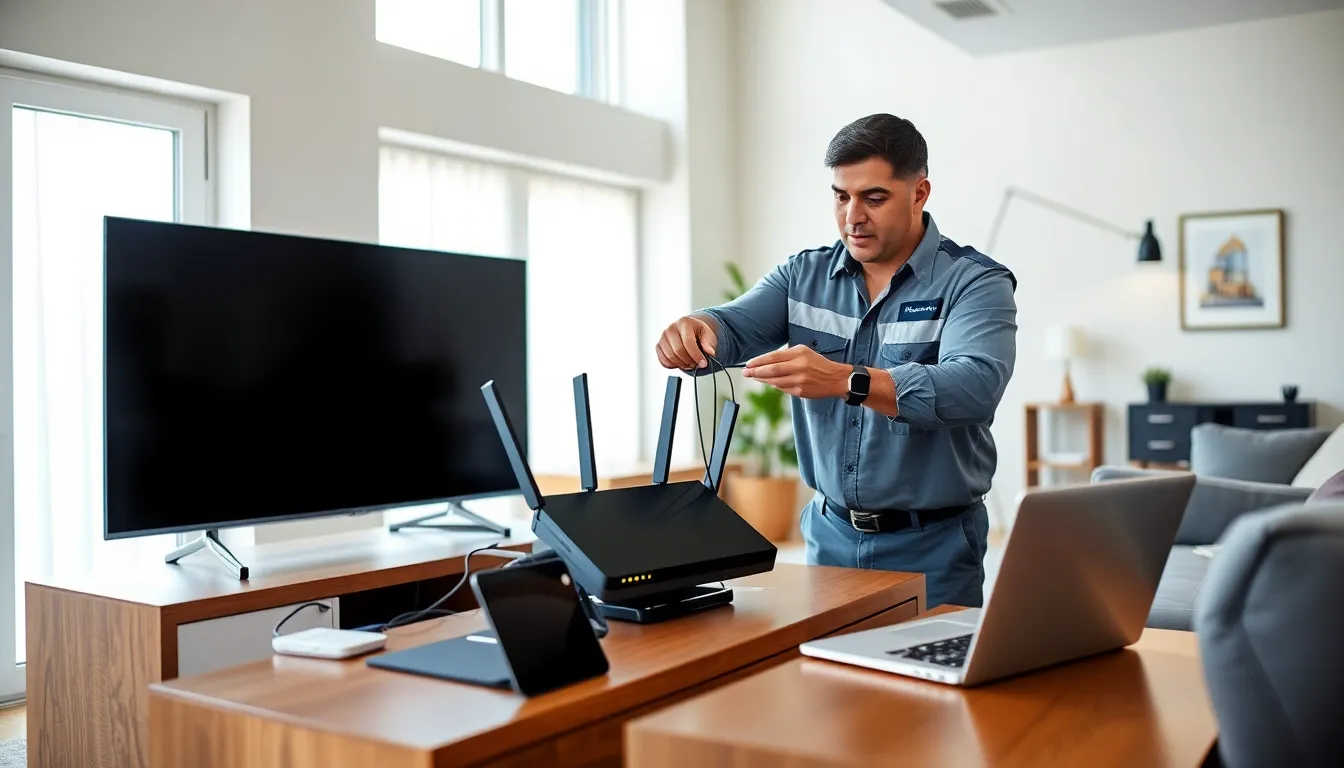Table of Contents
ToggleHave you ever faced the glitchy frustration of your Wi-Fi signal mysteriously dropping in the best part of your favorite show? You’re not alone. For many, setting up a home network can feel like navigating a maze blindfolded. Lucky for you, home networking installation services are here to transform those head-scratching moments into seamless streaming experiences. Let’s dive deep into the world of home networking, turn on your favorite playlist and get ready to explore the perks of going professional.
Understanding Home Networking

Home networking refers to connecting various devices within a household to share the internet connection, files, and resources. This usually includes computers, smartphones, smart TVs, and printers. An effective home network improves productivity and enhances entertainment experiences.
Understanding the fundamentals of home networking involves grasping concepts like bandwidth, latency, and security protocols. Bandwidth, for instance, is akin to the width of a water pipe: a wider pipe allows for more water flow, leading to a smoother streaming experience. Latency represents the delay incurred, while security protocols such as WPA2 ensure that your network remains private and secure from unauthorized access.
Types of Home Networks
There are primarily three types of home networks: wired, wireless, and hybrid.
- Wired Networks: Utilizes Ethernet cables to connect devices directly to the router. These networks offer stable connections, making them ideal for high-data tasks such as gaming or video editing.
- Wireless Networks: Mostly found in modern homes, they distribute internet content through Wi-Fi signals. The allure lies in their convenience, allowing users to roam freely without being tethered by cables.
- Hybrid Networks: Combine both wired and wireless setups, satisfying the best of both worlds. Homes may keep vital devices hardwired for stability while enjoying the flexibility of wireless connectivity for mobile gadgets.
Benefits of Professional Installation
Investing in professional home networking installation services can unlock multiple benefits:
- Expertise: Professionals possess the knowledge to identify the right equipment and configuration tailored to your specific needs. They ensure everything is set up to function optimally.
- Time-Saving: Who has hours to spare wrestling with cables? Professionals can complete installations quickly, leaving you enough time for your Netflix binge.
- Future-Proofing: Experts can anticipate future networking needs and set up systems that can easily scale as technology evolves.
- Troubleshooting: If a hiccup, a professional can diagnose and fix issues swiftly, keeping your network running smoothly.
Key Components of Home Networking
Every home network involves several critical components that work in harmony:
- Router: This device connects your home to the internet. It manages traffic between your devices and ensures data gets where it needs to go.
- Modem: Typically provided by your ISP, it converts signals from your internet service into a format your router can use.
- Switch: When multiple devices require wired connections, a switch expands your network, enabling additional hardwired connections.
- Access Points: These devices extend the coverage of your wireless network, especially in larger homes.
- Networking Cables: Vital for wired connections, high-quality Ethernet cables ensure a fast and reliable connection.
Choosing the Right Service Provider
When it comes to selecting a home networking installation service provider, keep these tips in mind:
- Experience: Look for companies with a proven track record and positive customer reviews. Seasoned professionals are usually more adept at navigating unexpected challenges.
- Services Offered: Ensure the provider covers all necessary aspects, from initial setup to maintenance. A one-stop-shop can save you time and efforts later on.
- Transparency: Look for clear pricing and detailed estimates. Avoid providers who conceal costs or push unnecessary services.
- Customer Support: Post-installation support is crucial. A provider that offers reliable customer care can make all the difference during unforeseen technical issues.
DIY vs. Professional Installation
The debate between DIY and professional installation is as old as time, or at least as old as home networking. DIY might seem appealing for the budget-conscious individual, but several pitfalls exist:
- Lack of Expertise: If the learning curve feels steep, DIY setups often lead to inefficient networks that can frustrate users with slow speeds and connection drops.
- Time Consuming: Installing a network yourself may initially save money, but can consume significant time, time that could be spent enjoying the internet instead.
- Trial and Error: Amateur setups can lead to a lot of head-scratching moments and setbacks. Conversely, professionals come equipped with solutions to common problems.
In many cases, the peace of mind that comes from knowing experts have handled everything far outweighs the DIY approach.







